Xu Da (1332-1385)
Village Friends

Xu Da was born 1332 in Zhongli village of Haozhou city in Fengyang county of Anhui Province, the same village as the famous Zhu Yuanzhang, the first Ming emperor.
Xu Da was to live in "interesting" times. China was ravaged by occupation, draught, famine and rebellion.
Warlords around the Yangtze River were battling for local supremacy while at the same time fencing off attempts to quell the unrest by the ruling Yuan dynasty.

Tomb Stone
Xu Da had already been playing warlike games with Zhu Yuanzhang when they were boys in the same village. Little did they know at the time that this would become their fate in life.

Young general
in a modern city
Capturing Beijing
As one of Zhu Yuanzhang's most loyal and best military leaders Xu Da led many of the crucial campaigns against the local warlords in the decade of 1357-67.
He captured all the key cities in central-east China including the final warlord capital of Suzhou, the surrender of which signaled the end of the Yangtze battles.

Masonry details
on general's back
over 620 years old
Together with Ming general Chang Yuchun, Xu Da shared the military leadership in the subsequent northern campaign against the Mongolian Yuan rulers' armies, the final push to oust the unpopular foe and occupier.
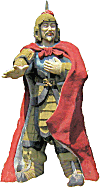
How did Xu Da earn his esteem?
Xu Da was an excellent general and a loyal servant of the emperor.
But that was not the only reason why he was held in high esteem by Zhu Yuanzhang.
Contrary to many of his fellow generals, Xu was able to enforce a strict discipline on his soldiers. Under penalty of death, they were not allowed to loot, rape and otherwise mistreat the inhabitants of the cities that had been captured.
This discipline was vital since other cities yet to be conquered would resist far less if they knew they could expect clemency.
It was even Xu Da, who personally led the Ming armies in the successful final battle for the Yuan capital of Dadu, aka. Khanbaliq. He took the capital on 14 September 1368, after which Zhu Yuanzhang promptly renamed it Beiping, meaning "peace in the north". This city is one and the same as Beijing, today's capital of China.
"Beiping" would remain just another city in the north of the empire until the third Ming Yongle Emperor made it capital again, when he moved the court from Nanjing in the early 15th century.
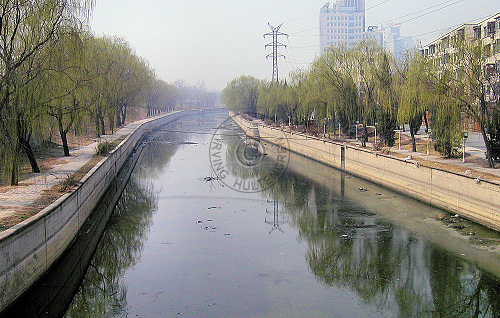
Moat and (left) remains of city wall at Andingmen
in Beijing, excavated and built by Xu Da in 1370-71
Unknown to most, it was Xu Da who in 1370-71 had the new northern Beijing city wall erected almost one mile to the south of the original Yuan wall. No longer a capital, the excess land was no longer needed and the more southern wall was easier to defend.
The Great Wall at Shanhaiguan
In 1379, not too long after Zhu had expelled the last Mongolian Yuan troops from China proper, he issued a royal edict ordering Xu Da and Zhu's military counselor, Liu Bowen, to find a suitable place for defense fortifications at a pass to the north of Beijing.

Shanhaiguan fortifications
Bohai Sea front right and
mountain rear left
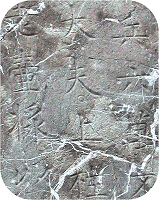
Stele inscription
with full stop
This was one of Zhu's master plans to keep the Yuan troops from reentering China. Xu and Liu were ordered to complete the project within two years.
They immediately traveled to the northern border and soon located an excellent spot where a wall could start by the Bohai Sea and connect up to mountains in the north.
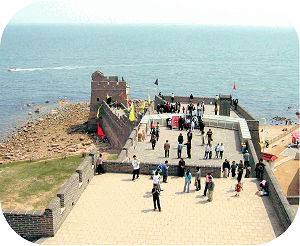
The Great Wall meets Bohai Sea
Not only was the location excellent for defense purposes but the mild climate and fertile countryside also made it a great place to live.
Back in their barracks they drafted the master plan and sent it back to the emperor for approval, which was granted.
It took one year and eight months to complete the project. The two leaders complemented each other well. Xu was an excellent leader and Liu possessed the engineering skills. The latter designed the wall within a wall concept. Walls connected to walls and watch towers ensured easy communication in case of attack.
Success is dangerous !!
But the story of Shanhaiguan doesn't end there. Returning from the audience with the emperor Liu Bowen told Xu that he would now be leaving for good. Surprised, Xu asked why the urgency?
Liu explained that the emperor was known for sharing adversities with his vassals but rarely shared success with others; Xu's and Li's lives were therefore inevitably now in grave danger.
To stay safe he urged Xu Da never to leave the Emperor's side; moreover, Xu should send his son to Shanhaiguan where he could be safe, lead a pleasant life and not die in battle.
Xu took the advice and sent his son to settle at the Shanhaiguan Pass where he indeed survived later purges by the emperor. His son's descendants later built a temple at Shanhaiguan in Xu Da's memory. Xu Da himself ensured to stay close to the emperor and died from natural causes.
Liu Bowen left the court without further notice and as far as we know he lived a frugal and happy life beyond the reach of the wrath of the emperor.
When they returned to the emperor he was pleased that Xu and Liu had not named the fortification as that had not been part of the imperial decree.
Liu suggested a name which would reflect that the fortification stretched from mountains in the north to the sea in the south.
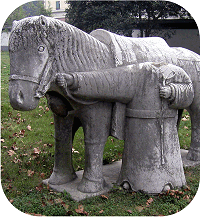
Horse with attendant
Taking the cue, Zhu Yuanzhang named it Shanhaiguan (Mountain and Sea Pass).
Xu's and Liu's masterpiece was made so robust that large parts of it has survived till today.
In fact, Shanhaiguan -also known as "The First Pass Under Heaven "- is a highly popular tourist destination for Chinese and foreigners alike.
Shanhaiguan is the eastern end of The Great Wall and can be reached by car in 3-4 hours from Beijing. Start very early in the morning for a one day trip!
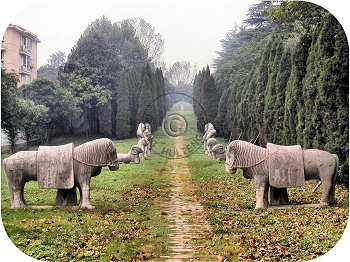
Xu Da's mausoleum
Sacred Way in front and
tomb mound far rear
King of the Hill
To the dismay of Zhu Yuanzhang, his brother in arms, Xu Da, died of illness in Nanjing already in 1385, barely 54 years old.
Zhu, now Ming Emperor with reign title of Hongwu, posthumously bestowed the title of King Zhongshan on Xu Da. He also permitted him to be buried on Zhongshan Mountain, the mountain chosen by Zhu Yuanzhang for his own mausoleum, Xiaoling.
Xu Da was bestowed the rank of "Weiguogong", a level right beneath the emperor himself. The title of "King of Zhongshan" is equally impressive inasmuch as it made him official king of the hill in which the Emperor himself was entombed.
They would thus remain brothers in arms forever, Xu Da faithfully at the emperors side fighting his battles for him.
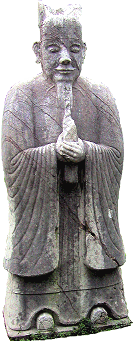
Civil official
The mausoleum

Memorial stele
with inscription by
the Hongwu Emperor
The tomb is located in Bancang village on the northern slopes of Mt. Zhongshan. It is almost one kilometer long and has a narrow layout, with a Sacred Way running the center line from entrance to tomb.
At the entrance is a stele resting in a tortoise. Emperor Hongwu personally authored the inscription, which recounts Xu Da's life story and all of his main merits and deeds. The inscription covers more than 2,000 characters.
The tablet is unique since it was written by the first Ming Emperor himself. Moreover, on close scrutiny one will notice that it actually has full stops at the end of each sentence! This is quite rare since people did not use punctuation marks in ancient times.
Behind the stele runs the about 220 meter long Sacred Avenue. It is lined with some of the traditional stone figures often found in Ming mausoleums.
The figures are in a remarkably good condition and bear witness to the importance and respect still applied to a person so essential to the founding of the Ming dynasty.

View from the
tomb mound
First is a pair of horses with servants followed by pairs of sheep, tigers, civil officials and, finally, military officers. The servants holding the horses have unfortunately been beheaded.

Xu Da's tomb mound
At the end of the sacred way are the remains of the ceremonial building, Ling'endian. By now only the elevated section of the palace is visible and that only barely so.
Another 700 meters back is the tomb itself, now just a small hill. The tomb is allegedly unopened since the burial of Xu Da.
The mausoleum is well kept and lined with evergreen trees rendering a very serene impression. The mausoleum is still quite quiet despite being close to a highway and some residential areas.